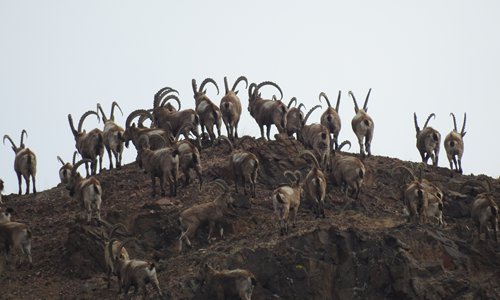HOME >> CHINA
Animals get dedicated migration pathway in Xinjiang national highway
Source:Global Times Published: 2019/6/23 18:43:52

About 100 wild goats appear at the Bortala Mongolian Autunomous Prefecture in the Xinjiang Uyghur Autonomous Region on April 13. Photo: IC
A dedicated route for wildlife migration has been built in the newly constructed national road between Fuyun county and Wucaiwan in Northwest China's Xinjiang Uyghur Autonomous Region.Crossing the Junggar Basin, the 216 national highway is expected to be put into operation on August 1. The project was launched in 2017, with environmental protection made the top priority. The bridge is 100 meters long, 50 meters wide and 6 meters high.
There are several culverts along the highway designed for wild animal migration.
In order to fit in with the surrounding environment, the passage is covered by a layer of sand, local news portal ts.cn reported on Friday.
Bridge construction has been completed and four drinking pools will be installed on both sides, so that water supplies are guaranteed for animals during animals' migration, Zhang Xiuzhen, chief engineer for one of the sections in the project, told the website.
Grass will be planted and animal feces will be placed to guide animals through, Zhang explained. Light-colored paint will be applied to prevent animal shock.
"For the project, the team has placed warning signs with environmental protection piles on both sides of the construction site. If wildlife activities are discovered along the animal passages, large-scale mechanical construction will be immediately reduced or stopped," the project's deputy chief told ts.cn.
Under the road, there is one viaduct and 21 animal passages for animal migration, according to Liu Weiwei, project environmental engineer for the 216 national highway.
"Within the range of animal migration routes, all these pathways' locations were decided by experts after years of observation of the migration trajectories of animals, and the sub-pathways help reduce the impact of driving on animal migration," Liu explained.
Animal crossings have been used for years in many countries by planting vegetation on them, simulating natural hillside terrain.
A 2,700-meter bridge opened to animals in 2013, according to a report by German news website thelocal.de in September 2013, featuring an "ecoduct" arched crossing passing over the B38 highway in Germany.
The 216 national highway will speed up the transportation and serve as rapid output for industrial products, a ts.cn report said.
Global Times
Posted in: IN-DEPTH,ENVIRONMENT